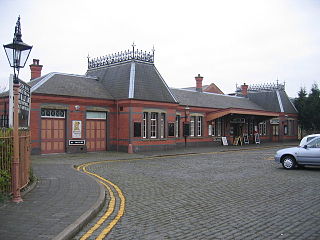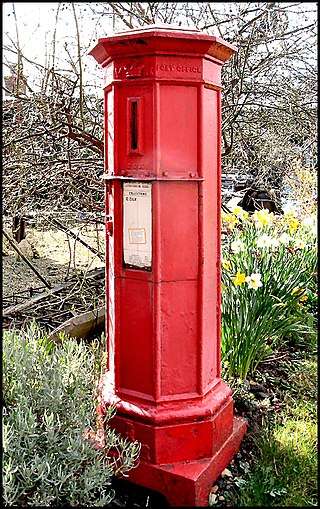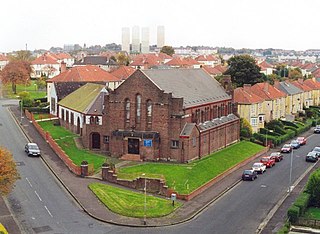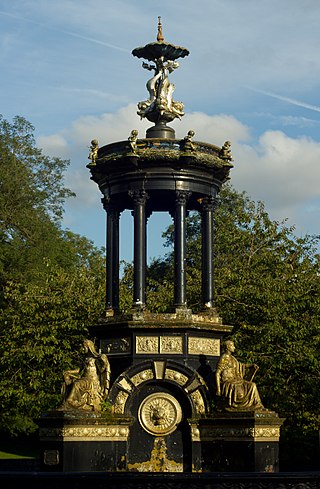
The Saracen Foundry was the better-known name for the Possilpark, Glasgow-based foundry company W MacFarlane & Co. Ltd, founded and owned by Walter MacFarlane. MacFarlane's was the most important manufacturer of ornamental ironwork in Scotland.

The Saracen Foundry was the better-known name for the Possilpark, Glasgow-based foundry company W MacFarlane & Co. Ltd, founded and owned by Walter MacFarlane. MacFarlane's was the most important manufacturer of ornamental ironwork in Scotland.

Walter Macfarlane was born in Torrance of Campsie, near Glasgow, in 1817. He worked for the jeweller William Russell, before serving an apprenticeship with blacksmith James Buchanan. He then spent a decade working for Moses, McCulloch & Co's Cumberland Foundry in Stockwell Street. [1]
With his own main home at 22 Park Circus, Glasgow, Macfarlane became a prominent figure in local politics, becoming the President of the Glasgow Liberal Association and a City Councillor. He died in 1885, and is buried in Glasgow Necropolis cemetery.[ citation needed ]

MacFarlane, with partners Thomas Russell and James Marshall, incorporated W MacFarlane & Co. Ltd in 1850. They took over a foundry works in Saracen Lane, behind the Saracen Head Inn, in the Gallowgate. The foundry had previously (from at least 1825) been in the control of Stephen Miller (father of Daniel Miller). [2] In 1862 the business relocated briefly to Washington Street. [1]
But the business kept growing, and MacFarlane needed a vast area of land on which to build both a foundry and a village-styled infrastructure on which to house his workforce. He agreed a deal with the son of Colonel Alexander Campbell of Possil to buy 100 acres (40 hectares) of his Possil estate in the mid-1860s, including the main estate house where Sir Archibald Alison, 1st Baronet the Sheriff of Lanarkshire resided, on which to build his new foundry works.
MacFarlane oversaw the removal of all the trees, creating the foundry on 14 acres (5.5 hectares), with its main gates at 73 Hawthorn Street. After creating railway access to his foundry from both the North British Railway and the Hamiltonhill Branch of the Caledonian Railway, MacFarlane laid out the rest of the park land as streets and houses, including naming the street fronting his factory "Saracen Street." [3]

MacFarlane renamed the location Possilpark, which went from being residence to 10 people in 1872, to 10,000 in less than two decades later in 1891. The developing layout of Possilpark was described by the then Glasgow Town Council as: "Their work is one of the finest and best conducted in Glasgow, and the new suburb of Possil Park, laid out by them with skill and intelligence, is rapidly becoming an important addition to the great city." [4] Ironically, the foundry's pollution earned Macfarlane the nickname "the Laird of Fossiltown."

Having joined the firm in 1871, in 1880 Macfarlane's nephew, Walter Macfarlane II (1853–1932), became a partner. On succeeding to the position of owner at the death of his uncle, the young MacFarlane set about making design and standardisation the key to the company's development.
Subsequently, the Saracen Foundry made to a set of standard designs, a series of decorative iron works, from railings, drinking fountains, bandstands, street lamps, pre-fabricated buildings and architectural features. To achieve the design edge they required, the firm employed the best Glasgow architects, including John Burnet, James A Ewing, James Sellars, and Alexander 'Greek' Thomson. James Boucher was commissioned to design the show rooms of the Possilpark foundry as a gigantic showcase for the products, complete with a glass and iron dome and elaborate decorative castings on its Gothic gateway. The works were exported all over the British Empire, [5] and can still be found in abundance in many parts of North Glasgow.

Macfarlane's most celebrated work is the Saracen Fountain in Alexandra Park, Glasgow, which they gave to the city after exhibiting it in the grounds of the 1901 Glasgow International Exhibition. Designed by D W Stevenson, and using casts of the figures around his earlier 1878 statue of John Platt in Oldham, the fountain featured in the firm's advertising. Copies were later commissioned and erected in: Town Hall Park, Warrington (destroyed for the war effort, 1942; a model version in silver is in the collection of Warrington Borough Council); and the Sammy Marks fountain in the National Zoological Gardens, Pretoria, South Africa. [1]
In the 1860s, John Kibble designed a conservatory for his home at Coulport on Loch Long. However, after production at the Saracen Foundry, it was shipped up the River Clyde by barge to the Glasgow Botanic Gardens, and fully erected at its current location in 1873 by Boyd of Paisley. The Kibble Palace building structure is of curved wrought iron and glass supported by cast iron beams resting on ornate columns, surmounted on masonry foundations. It was initially used as an exhibition and concert venue, before being used for growing plants from the 1880s. Benjamin Disraeli and William Ewart Gladstone were both installed as rectors of the University of Glasgow in the palace, in 1873 and 1879 respectively - its last use as a public events venue, before becoming wholly used for the cultivation of temperate plants. The main plant group is the collection of Australian tree ferns, some of which have lived here for 120 years. In 2004 a £7 million restoration programme was initiated, which involved the complete dismantling of the Palace, and the removal of the parts to Shafton, South Yorkshire for specialised repair and conservation. [6]
Owing to their earlier tie-ins with the architectural trade, between the two world wars Saracen Foundry produced many cast-iron panels for commercial buildings, including the former Union Bank on St Vincent Street (1924-7); Selfridges in London (1928) and the Art Deco Burton's on Argyle Street (1930). However, the Second World War wreaked havoc on Possilpark in two ways: firstly, by making its industrial works a vast and well-lit target; and secondly when the Minister of Supply and the Ministry of Production made the recovery of iron a key component in increasing war production, removing much of the footprint of Saracen's contribution to the world.
After the war, the combination of the collapse of the British Empire, the move away from steam power and the adaptation of new designs and materials meant a vast decline in orders for Saracen's standard designs. The MacFarlane company moved into standard foundry work, including being one of five foundries casting Sir Giles Gilbert Scott's classic K6 Telephone box for Post Office Telephones.
MacFarlane's was taken over by Allied Founders in 1965, which was itself absorbed by Glynwed Ltd. Possilpark was by this time underinvested and rather decrepit, and so the works closed and the infrastructure demolished in 1967. [1] The site is now occupied by Allied Vehicles and Possilpark Industrial Estate.[ citation needed ]
Owing to the long duration of the factory's life, and the wide distribution of their works, Saracen Foundry pieces can be seen in most parts of the world. Those of note include:
Some royal coats of arms can be seen in former HM Customs & Excise Offices. The Pembroke Dock Custom House, now Home Home Office Border Force, has a well-maintained example that started life at Custom House Milford Haven. The Fishguard Customs CoA was scrapped by the building maintenance contractor as the mounting was highly corroded.
The crestings at Kidderminster Town railway station on the Severn Valley Railway are modern replicas. The patterns for the castings were produced by measurement of broken remnants of those similar ones recovered from Ross-on-Wye railway station shortly after it was demolished. At the request of the structural engineer for Kidderminster Town railway station the replicas were produced in aluminium. These are of a similar pattern to those on parts of Slough Railway station, Dartmouth Railway station and HSBC Bank in Derby.


Alexandra Park is a public park in the East End of Glasgow, Scotland. It is located in Dennistoun, 2 miles (3 km) east of the city centre. Named after Princess Alexandra of Denmark, it opened in 1870. The highest point of the park gives views north to Ben Lomond and south to the Tinto Hills. The park is generally open from dawn to dusk daily, but the facilities inside the park have separate opening and closing times accordingly.

Lalbagh Botanical Garden or simply Lalbagh, is an botanical garden in Bangalore, India, with an over 200-year history. First planned and laid out during the dalavaiship of Hyder Ali, the garden was later managed under numerous British Superintendents before Indian Independence. It was responsible for the introduction and propagation of numerous ornamental plants as well as those of economic value. It also served a social function as a park and recreational space, with a central glass house dating from 1890 which was used for flower shows. In modern times, it hosts two flower shows coinciding with the week of Republic Day and Independence Day. As an urban green space along with Cubbon Park, it is also home to numerous wild species of birds and other wildlife. The garden also has a lake adjoining a large rock on which a watchtower had been constructed during the reign of Kempegowda II.

Glasgow Botanic Gardens is a botanical garden located in the West End of Glasgow, Scotland. It features several glasshouses, the most notable of which is the Kibble Palace.

Cowlairs is an area in the Scottish city of Glasgow, part of the wider Springburn district of the city. It is situated north of the River Clyde, between central Springburn to the east and Possilpark to the west.

Possilpark, colloquially known as Possil, is a district in the Scottish city of Glasgow, situated north of the River Clyde and centred around Saracen Street. The area developed around Saracen Foundry of Walter MacFarlane & Co., which was the main employer. In the wake of the Saracen Foundry's closure in 1967, this part of Glasgow became one of the poorest in the United Kingdom, and decades later deprivation and crime rates remain high.

Ballymoney railway station serves the town of Ballymoney in County Antrim, Northern Ireland.

Kidderminster Town is a railway station situated in the town of Kidderminster, Worcestershire, England. It is operated by the Severn Valley Railway, a heritage line which runs from Kidderminster to Bridgnorth. The station was opened on 30 July 1984, was built in a late Victorian style, and shares its station approach and car park with the adjacent National Rail station.

Andrew Handyside and Company was an iron founder in Derby, England, in the nineteenth century.

Barton Arcade is a Victorian shopping arcade in Manchester, England, located between Deansgate and St Ann's Square. It was constructed by Corbett, Raby, and Sawyer in 1871.
22 Park Circus is a 19th-century townhouse in the West End of Glasgow, Scotland. Originally a family home, it was later a club and an Italian consulate. From 1994 to 2013 the building housed the city's register office.

Port Dundas is an area of Glasgow, Scotland, located 1 mile (1.6 km) to the north of the city centre. It lies to the north of Cowcaddens, and to the west of Sighthill, with Hamiltonhill and Possilpark to the north-west.

The Glasgow International Exhibition was the second of 4 international exhibitions held in Glasgow, Scotland during the late 19th and early 20th centuries. The exhibition took place during a period of half-mourning requested by Edward VII but was still popular and made more than £35000 profit. The exhibition was opened by the King's daughter, the Princess Louise, Duchess of Fife.

A pissoir is a French invention, common in Europe, that provides a urinal in public space with a lightweight structure. The availability of pissoirs aims to reduce urination onto buildings, sidewalks, or streets. They can be freestanding and without screening, with partial screening, or fully enclosed.

Queen's Park is a heritage-listed botanic garden at Sussex Street, Maryborough, Fraser Coast Region, Queensland, Australia. A reserve for the botanical gardens was gazetted in October 1873. It contains the Maryborough War Memorial. It was added to the Queensland Heritage Register on 21 October 1992.

Parkhouse is a neighbourhood of Glasgow, Scotland. Within the G22 postcode area and the Canal ward of the Glasgow City Council administration, it is mainly residential in character having been constructed as a development primarily consisting of cottage flats in the early 1930s, prior to which it was open farmland.

Rondebosch Fountain is an ornamental Victorian drinking trough for horses, standing on a traffic island on the intersection between Belmont Road and Main Road in the centre of Rondebosch in Cape Town, South Africa. It was declared a National Monument on 10 April 1964.

Overtoun Park is a public park in Rutherglen, South Lanarkshire, Scotland.
Possilpark Football Club was a 19th-century football club from the Possilpark area of Glasgow in Scotland. The club no longer exists and has been replaced by Glasgow Perthshire F.C., which plays in the West of Scotland Football League.
Carrick Football Club was a 19th-century football club originally from the Partick area of Glasgow in Scotland, but which moved to Possilpark for a brief period.

The Saracen Fountain is a large, ornate fountain located in Alexandra Park, Glasgow, Scotland. It was made of cast iron by Macfarlane & Co.'s Saracen Foundry for the 1901 Glasgow International Exhibition and presented to the city as a gift by foundry owner Walter Macfarlane. It is influenced by the Choragic Monument of Lysicrates in Athens.